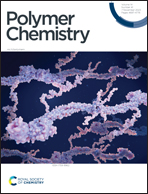Naphthalene-based semiconducting microporous polyimides for high-efficiency photo-catalytic dye degradation†
Abstract
Microporous polyimides (MPIs) with an extended π-conjugated structure have attracted interest thanks to the synergetic effects between large surface areas and semiconducting characteristics plus their anticipated photo-catalysis applications. In this study, three naphthalene-based semiconducting MPIs with a maximum surface area of 1909 m2 g−1 have been prepared within 30 min via a solvothermal method, as developed in our previous work. The fully conjugated skeleton retaining imide-functional linkages endows the resultant polymers with semiconducting characteristics. When they work as photo-catalysts under visible light irradiation, photo-degradation efficiencies reach 97% within 50 min and 90% within 60 min for methylene blue (MB) and rhodamine B (RhB), respectively. Under the irradiation of natural sunlight, the photo-catalytic degradation efficiencies of MB and RhB still reach 93% and 89%, respectively. Besides, naphthalene-based semiconducting MPIs exhibit excellent reusability, photo-catalytic sequentiality and selectivity. The photo-catalytic mechanism study indicates that the major reactive species involved in the photo-degradation are active oxygen species and electrons. This work reveals a green photo-catalytic approach for dye degradation, bridging the gap between a sustainable preparation strategy and bright prospect for high-performance MPIs.



 Please wait while we load your content...
Please wait while we load your content...